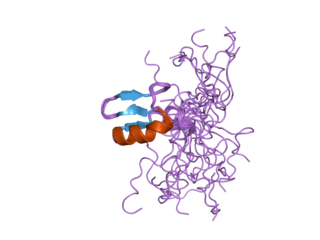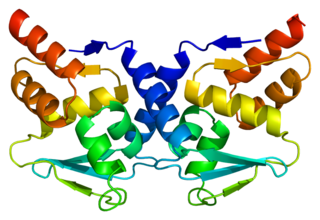BCL-6 corepressor is a protein that in humans is encoded by the BCOR gene. [5] [6]
BCL-6 corepressor is a protein that in humans is encoded by the BCOR gene. [5] [6]
The protein encoded by this gene was identified as an interacting corepressor of BCL6, a POZ/zinc finger transcription repressor that is required for germinal center formation and may influence apoptosis. This protein selectively interacts with the POZ domain of BCL6, but not with eight other POZ proteins. Specific class I and II histone deacetylases (HDACs) have been shown to interact with this protein, which suggests a possible link between the two classes of HDACs. At least four alternatively spliced transcript variants, which encode different isoforms, have been reported for this gene. [6]
Mutations in the BCOR gene cause a form of syndromic microphthalmia (small eye) called MCOPS2. This syndrome incorporates microphthalmia, congenital cataracts, cardiac defects, dental defects and skeletal anomalies. Mutations in this gene have also been found associated to acute myeloid leukemia. [7]
BCOR has been shown to interact with MLLT3 [8] and BCL6. [5]
Microphthalmia, also referred as microphthalmos, is a developmental disorder of the eye in which one or both eyes are abnormally small and have anatomic malformations. Microphthalmia is a distinct condition from anophthalmia and nanophthalmia. Although sometimes referred to as 'simple microphthalmia', nanophthalmia is a condition in which the size of the eye is small but no anatomical alterations are present.

Anophthalmia is the medical term for the absence of one or both eyes. Both the globe and the ocular tissue are missing from the orbit. The absence of the eye will cause a small bony orbit, a constricted mucosal socket, short eyelids, reduced palpebral fissure and malar prominence. Genetic mutations, chromosomal abnormalities, and prenatal environment can all cause anophthalmia. Anophthalmia is an extremely rare disease and is mostly rooted in genetic abnormalities. It can also be associated with other syndromes.

Histone deacetylase 1 (HDAC1) is an enzyme that in humans is encoded by the HDAC1 gene.

The nuclear receptor co-repressor 2 (NCOR2) is a transcriptional coregulatory protein that contains several nuclear receptor-interacting domains. In addition, NCOR2 appears to recruit histone deacetylases to DNA promoter regions. Hence NCOR2 assists nuclear receptors in the down regulation of target gene expression. NCOR2 is also referred to as a silencing mediator for retinoid or thyroid-hormone receptors (SMRT) or T3 receptor-associating cofactor 1 (TRAC-1).

In genetics and molecular biology, a corepressor is a molecule that represses the expression of genes. In prokaryotes, corepressors are small molecules whereas in eukaryotes, corepressors are proteins. A corepressor does not directly bind to DNA, but instead indirectly regulates gene expression by binding to repressors.

Chromodomain-helicase-DNA-binding protein 7 is an ATP-dependent 'chromatin' or 'nucleosome' remodeling factor that in humans is encoded by the CHD7 gene.

Homeobox expressed in ES cells 1, also known as homeobox protein ANF, is a homeobox protein that in humans is encoded by the HESX1 gene.

Bcl-6 is a protein that in humans is encoded by the BCL6 gene. BCL6 is a master transcription factor for regulation of T follicular helper cells proliferation. BCL6 has three evolutionary conserved structural domains. The interaction of these domains with corepressors allows for germinal center development and leads to B cell proliferation.

Zinc finger and BTB domain-containing protein 16 is a protein that in humans is encoded by the ZBTB16 gene.

Histone deacetylase 4, also known as HDAC4, is a protein that in humans is encoded by the HDAC4 gene.

Homeobox protein MSX-1, is a protein that in humans is encoded by the MSX1 gene. MSX1 transcripts are not only found in thyrotrope-derived TSH cells, but also in the TtT97 thyrotropic tumor, which is a well differentiated hyperplastic tissue that produces both TSHß- and a-subunits and is responsive to thyroid hormone. MSX1 is also expressed in highly differentiated pituitary cells which until recently was thought to be expressed exclusively during embryogenesis. There is a highly conserved structural organization of the members of the MSX family of genes and their abundant expression at sites of inductive cell–cell interactions in the embryo suggest that they have a pivotal role during early development.

Homeobox protein Hox-A13 is a protein that in humans is encoded by the HOXA13 gene.

Homeobox protein SIX3 is a protein that in humans is encoded by the SIX3 gene.

Zinc finger and BTB domain-containing protein 7A is a protein that in humans is encoded by the ZBTB7A gene.

B-cell lymphoma/leukemia 11A is a protein that in humans is encoded by the BCL11A gene.

Protein AF-9 is a protein that in humans is encoded by the MLLT3 gene.

Visual system homeobox 2 is a protein that in humans is encoded by the VSX2 gene.

Polycomb group RING finger protein 1, PCGF1, also known as NSPC1 or RNF68 is a RING finger domain protein that in humans is encoded by the PCGF1 gene.

Oculofaciocardiodental syndrome is a rare X-linked dominant genetic disorder.

(HES7) or bHLHb37 is protein coding mammalian gene found on chromosome 17 in humans. HES7 is a member of the Hairy and Enhancer of Split families of Basic helix-loop-helix proteins. The gene product is a transcription factor and is expressed cyclically in the presomitic mesoderm as part of the Notch signalling pathway. HES7 is involved in the segmentation of somites from the presomitic mesoderm in vertebrates. The HES7 gene is self-regulated by a negative feedback loop in which the gene product can bind to its own promoter. This causes the gene to be expressed in an oscillatory manner. The HES7 protein also represses expression of Lunatic Fringe (LFNG) thereby both directly and indirectly regulating the Notch signalling pathway. Mutations in HES7 can result in deformities of the spine, ribs and heart. Spondylocostal dysostosis is a common disease caused by mutations in the HES7 gene. The inheritance pattern of Spondylocostal dysostosis is autosomal recessive.